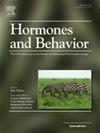A survey of hypothalamic phenotypes identifies molecular and behavioral consequences of MYT1L haploinsufficiency in male and female mice
IF 2.4
3区 医学
Q2 BEHAVIORAL SCIENCES
引用次数: 0
Abstract
The transcription factor MYT1L supports proper neuronal differentiation and maturation during brain development. MYT1L haploinsufficiency results in a neurodevelopmental disorder characterized by intellectual disability, developmental delay, autism, behavioral disruptions, aggression, obesity and epilepsy. While MYT1L is expressed throughout the brain, how it supports proper neuronal function in distinct regions has not been assessed. Some features of MYT1L Neurodevelopmental Syndrome suggest disruption of hypothalamic function, such as obesity and endocrine issues, and previous research showed changes in hypothalamic neuropeptide expression following knockdown in zebrafish. Here, we leveraged our heterozygous Myt1l mutant, previously shown to recapitulate aspects of the human syndrome such as hyperactivity, social challenges, and obesity, to examine the impact of MYT1L loss on hypothalamic function. Examining the molecular profile of the MYT1L haploinsufficient hypothalamus revealed a similar scale of disruption to previously studied brain regions, yet with region-specific roles for MYT1L, including regulation of neuropeptide systems. Alterations in oxytocin and arginine vasopressin cell numbers were also found. Behaviors studied included maternal care, social group hierarchies, and aggression, all of which were unchanged. Feeding and metabolic markers were also largely unchanged in MYT1L haploinsufficient mice, yet an interaction was observed between diet and MYT1L genotype on weight gain. Our findings here suggest that gross endocrine function was not altered by MYT1L haploinsufficiency, and that key sex-specific behaviors related to proper hypothalamic function remain intact. Further study is needed to understand the functional impact of the altered hypothalamic molecular profile and changes in neuropeptide cell numbers that result from MYT1L haploinsufficiency.
一项下丘脑表型调查确定了雄性和雌性小鼠MYT1L单倍性不足的分子和行为后果
转录因子MYT1L在大脑发育过程中支持适当的神经元分化和成熟。MYT1L单倍体功能不全导致以智力残疾、发育迟缓、自闭症、行为中断、攻击、肥胖和癫痫为特征的神经发育障碍。虽然MYT1L在整个大脑中表达,但它如何在不同区域支持适当的神经元功能尚未得到评估。MYT1L神经发育综合征的一些特征提示下丘脑功能的破坏,如肥胖和内分泌问题,先前的研究表明,在斑马鱼中敲除后下丘脑神经肽的表达发生了变化。在这里,我们利用我们的杂合Myt1l突变体,先前显示概括了人类综合征的各个方面,如多动、社交挑战和肥胖,来研究Myt1l丢失对下丘脑功能的影响。检查MYT1L单倍体不足下丘脑的分子图谱揭示了与先前研究的大脑区域相似的破坏规模,但MYT1L具有区域特异性作用,包括神经肽系统的调节。催产素和精氨酸抗利尿激素细胞数量的变化也被发现。研究的行为包括母性照顾、社会群体等级和攻击性,所有这些都没有变化。在MYT1L单倍型不足的小鼠中,喂养和代谢标志物也基本不变,但观察到饮食和MYT1L基因型对体重增加有相互作用。我们的研究结果表明,总内分泌功能不会因MYT1L单倍功能不全而改变,与下丘脑正常功能相关的关键性别特异性行为保持不变。MYT1L单倍体功能不全对下丘脑分子谱改变和神经肽细胞数量变化的功能影响尚需进一步研究。
本文章由计算机程序翻译,如有差异,请以英文原文为准。
求助全文
约1分钟内获得全文
求助全文
来源期刊

Hormones and Behavior
医学-行为科学
CiteScore
6.70
自引率
8.60%
发文量
139
审稿时长
91 days
期刊介绍:
Hormones and Behavior publishes original research articles, reviews and special issues concerning hormone-brain-behavior relationships, broadly defined. The journal''s scope ranges from laboratory and field studies concerning neuroendocrine as well as endocrine mechanisms controlling the development or adult expression of behavior to studies concerning the environmental control and evolutionary significance of hormone-behavior relationships. The journal welcomes studies conducted on species ranging from invertebrates to mammals, including humans.
 求助内容:
求助内容: 应助结果提醒方式:
应助结果提醒方式:


